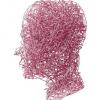Just came across a study where they looked into the BDNF hypothesis of Depression, and compared it to the Serotonin-theory, and it seems as is the conclusion is that there's merit to both theories.
Personally, I'm starting to think it's actually something similar to the pathology of Schizophrenia - where there are two competing theories, the Glutamatergic and the Dopaminergic theories respectively. There's been a decades-long debate regarding that, and finally, the solution seems to have been found - Kynurenic Acid theory unifies the two, and establishes a clear connection between the two neurotransmitters.
Most likely, depression is the same. So, hypothetically, perhaps there's a yet to be discovered connecting process that creates a disturbance in both neurotransmitters and BDNF, in depression?
There's a few that we can strike right off the bat here, because we KNOW they're no damn good.
??Mirtazapine - turns you into a slow-moving tub of lard. Cut.??
Imipramine - too many finicky side-effects, it's a TCA after all. Cut.
Agomelatine - too inefficient. Not really effective in treating severe depression.
Sertraline (SSRI) - discontinuation-symptoms are quite severe, known to cause insomnia. Cut.
Venlafaxine (SNRI) - known to have the WORST discontinuation-symptoms of them all. Insomnia. Cut!
Escitalopram (SSRI) - one of the most selective of all of the SSRI's, proven to be one of the most effective in a study a few years back.
"Comparative efficacy and acceptability of 12 new-generation antidepressants: a multiple-treatments meta-analysis"
http://www.thelancet...0046-5/fulltext
Synergistic antidepressant-like action of gaboxadol and escitalopram.
http://www.ncbi.nlm....pubmed/22406239
Synergistic neurochemical and behavioural effects of acute intrahippocampal injection of brain-derived neurotrophic factor and antidepressants in adult mice.
http://www.dpag.ox.a...ications/426704
Injections with BDNF doesn't seem like a very practical solution tho, NOR 7,8-DIHYDROFLAVONE'... Low-dose Gaboxadol however, does seem like it.
Does anybody know about any other compounds that are synergistic with other SSRI's? It might work with Escitalopram as well.
Found this last night about blueberries and SSRIs and norepinephrine(albeit in a PTSD animal model):
"Traumatized rats fed a plain diet (no blueberries) did not show much of a serotonin increase, but instead demonstrated a predictable rise in norepinephrine—a neurotransmitter that often spikes in response to trauma."
"NE-induced increase in oxidative stress, nuclear condensation, calpain activity and lowering of SOD and CAT activities were prevented upon pretreatment with blueberry fraction"
Blueberries Show Promise as Treatment for Post-Traumatic Stress Disorder
Recently, we demonstrated that over-activation of norepinephrine (NE) along with serotonin (5-HT) as the possible reason for the lack of efficacy of SSRI. Hence, there is a need for novel therapeutic approaches for the treatment of PTSD. In this study, we investigated the neuroprotective role of blueberries (BB) in modulating neurotransmitter levels in PTSD. Rats were fed with a blueberry-enriched (2 percent) or a control diet. Rats were exposed to cats for one hour on days 1 and 11 of a 31-day schedule to simulate traumatic conditions. At the end of the study, the rats were euthanized and PFC and HC were isolated. We measured monoamines and their metabolites by high-performance liquid chromatography. In our PTSD model, NE levels were increased and 5-HT levels were decreased when compared to control. In contrast, a BB diet increased 5-HT without affecting NE levels.
My pot dealer takes citalopram and he's like way chill, at least compared to crazy wife lady.
Serotonin is BDNF-enhancing (so in a way it's merits to one theory!), except usually 5-HT2C, which is primarily inhibitory.
Most SSRIs upregualte BDNF, fluoxetine too[!].
Kynrenic acid blocks glutamate, 5-HT2C blocks dopamine, so maybe that's analogous to "kynurenic acid" of depression??
Also, GABA and dopamine co-regulate each other[addition source]. So that opens other avenues to research.
Serotonin 5-HT2C receptors as a target for the treatment of depressive and anxious states: focus on novel therapeutic strategies.
Serotonin (5-HT)2C receptors play an important role in the modulation of monoaminergic transmission, mood, motor behaviour, appetite and endocrine secretion, and alterations in their functional status have been detected in anxiodepressive states. Further, 5-HT2C sites are involved in the actions of several classes of antidepressant. At the onset of treatment, indirect activation of 5-HT2C receptors participates in the anxiogenic effects of selective 5-HT reuptake inhibitors (SSRIs) as well as their inhibition of sleep, sexual behaviour and appetite. Conversely, progressive down-regulation of 5-HT2C receptors parallels the gradual onset of clinical efficacy of SSRIs. Other antidepressants, such as nefazodone or mirtazapine, act as direct antagonists of 5-HT2C receptors. These observations underpin interest in 5-HT2C receptor blockade as a strategy for treating depressive and anxious states. This notion is supported by findings that 5-HT2C receptor antagonists stimulate dopaminergic and adrenergic pathways, exert antidepressant and anxiolytic actions in behavioural paradigms, and favour sleep and sexual functio n. In addition to selective antagonists, novel strategies for exploitation of 5-HT2C receptors embrace inverse agonists, allosteric modulators, ligands of homo/heterodimers, modulators of interactions with 'postsynaptic proteins', dual melatonin agonists/5-HT2C receptor antagonists and mixed 5-HT2C/alpha2-adrenergic antagonists. Intriguingly, there is evidence that stimulation of regionally discrete populations of 5-HT2C receptors is effective in certain behavioural models of antidepressant activity, and promotes neurogenesis in the hippocampus. This article explains how these ostensibly paradoxical actions of 5-HT2C antagonists and agonists can be reconciled and discusses both established and innovative strategies for the exploitation of 5-HT2C receptors in the improved management of depressed and anxious states.
The interaction between GABA and dopamine: implications for schizophrenia.
A role for gamma-aminobutyric acid (GABA) in the pathophysiology of schizophrenia was first suggested by Eugene Roberts in 1972. Since then considerable work has been accomplished in both the clinical and basic sciences regarding GABA and schizophrenia. Although it was originally thought that GABA might be useful in treating schizophrenia because of its inhibition of dopaminergic activity, recent data have shown that in certain models GABA has the opposite effect on dopaminergic functions. Regardless of the relationships of GABA to dopamine, neither biochemical nor pharmacological studies have been able to demonstrate a clear and reproducible GABA disturbance in schizophrenia. A number of problems contribute to the difficulty in studying GABA in schizophrenia, including the lack of specific and nontoxic GABA agonists as well as the complexity of the GABA system in brain. Interest in GABA research in schizophrenia appears to have waned, but several areas nevertheless appear promising for clinical investigation
New Insights into the Mechanisms Underlying the Effects of BDNF on Eating Behavior
Previous work indicated that hypothalamic BDNF participates in homeostatic processes that preserve energy levels essential for survival. Recently, we demonstrated an intimate involvement of BDNF in the regulation of hedonic feeding via the positive modulation of the mesolimbic dopamine pathway (Cordeira et al, 2010). This neural circuit mediates motivated and reward-seeking behaviors, including consumption of palatable food, and has well-established roles in drug addiction. Mice with selective deletion of Bdnf in the ventral tegmental area (VTA), a principal source of mesolimbic BDNF, consumed significantly more palatable high-fat food than control mice, while exhibiting normal intake of standard chow. Furthermore, evoked release of dopamine by mesolimbic fibers in the nucleus accumbens was diminished in mice lacking central BDNF, suggesting decreased VTA dopamine neuron activity and concomitant reductions in neurotransmitter release. It was proposed previously that hypoactivity of the mesolimbic system might result in reward deficiency syndrome and, behaviorally, in compensatory overeating to enhance a deficient dopaminergic system. In support of this model, hyperphagic leptin-deficient mice were also reported to have reduced evoked dopamine release in the nucleus accumbens (Fulton et al, 2006). Moreover, we found that administration of a dopamine-1 receptor agonist abrogated overeating in BDNF mutant mice. The results argue strongly that BDNF is a natural modulator of hedonic food intake and that dysregulation of BDNF signaling in the reward circuitry increases the drive to eat in the absence of a homeostatic requirement.
Essential role of BDNF in the mesolimbic dopamine pathway in social defeat stress.
Mice experiencing repeated aggression develop a long-lasting aversion to social contact, which can be normalized by chronic, but not acute, administration of antidepressant. Using viral-mediated, mesolimbic dopamine pathway-specific knockdown of brain-derived neurotrophic factor (BDNF), we showed that ??BDNF is required for the development of this experience-dependent social aversion??. Gene profiling in the nucleus accumbens indicates that local knockdown of BDNF obliterates most of the effects of repeated aggression on gene expression within this circuit, with similar effects being produced by chronic treatment with antidepressant. These results establish an essential role for ??BDNF in mediating long-term neural and behavioral plasticity in response to aversive social experiences??.
BDNF controls dopamine D3 receptor expression and triggers behavioural sensitization.
Brain-derived neurotrophic factor (BDNF), like other neurotrophins, is a polypeptidic factor initially regarded to be responsible for neuron proliferation, differentiation and survival, through its uptake at nerve terminals and retrograde transport to the cell body. A more diverse role for BDNF has emerged progressively from observations showing that it is also transported anterogradely, is released on neuron depolarization, and triggers rapid intracellular signals and action potentials in central neurons. Here we report that BDNF elicits long-term neuronal adaptations by controlling the responsiveness of its target neurons to the important neurotransmitter, dopamine. Using lesions and gene-targeted mice lacking BDNF, we show that BDNF from dopamine neurons is responsible for inducing normal expression of the dopamine D3 receptor in nucleus accumbens both during development and in adulthood. BDNF from corticostriatal neurons also induces behavioural sensitization, by triggering overexpression of the D3 receptor in striatum of hemiparkinsonian rats. Our results suggest that BDNF may be an important determinant of pathophysiological conditions such as drug addiction, schizophrenia or Parkinson's disease, in which D3 receptor expression is abnormal.
Modulation of striatal quinolinate neurotoxicity by elevation of endogenous brain kynurenic acid
nicotinylalanine exerts its effect by increasing levels of endogenous kynurenic acid in the brain. The results of this study suggest that agents which influence levels of endogenous excitatory amino acid antagonists such as kynurenic acid may be useful in preventing excitotoxic damage
Nicotinylalanine increases the formation of kynurenic acid in the brain and antagonizes convulsions
antagonism of the NMDA receptors. In fact, NAL antagonized sound-induced seizures and prevented death in DBA/2 mice. Pretreatment of the mice with D-serine (100 micrograms intracerebroventricularly), a glycine agonist and a competitive antagonist of KYNA, completely prevented the anticonvulsive action of NAL. These data suggest that changes in the extracellular concentration of KYNA in the brain are associated with a modulation of NMDA receptor function.
Effects of kynurenic acid as a glutamate receptor antagonist in the guinea pig.
Glutamate excitotoxicity is implicated in both the genesis of neural injury and noise-induced hearing loss (NIHL). Acoustic overstimulation may result in excessive synaptic glutamate, resulting in excessive binding to post-synaptic receptors and the initiation of a destructive cascade of cellular events, thus leading to neuronal degeneration and NIHL. The purpose of this study was to determine whether this apparent excitotoxicity can be attenuated by kynurenic acid (KYNA), a broad-spectrum glutamate receptor antagonist, and protect against noise-induced temporary threshold shifts (TTS). Guinea pigs were randomly assigned to three separate groups. Base-line compound action potentials (CAP) thresholds and cochlear microphonics (CM) were recorded. Group I was treated with physiologic saline as a vehicle control applied to the round window membrane that was followed by 110 dB SPL wide-band noise for 90 min. Group II received 5 mM KYNA followed by noise exposure, and group III received 5 mM KYNA alone without noise exposure. Post-drug and noise levels of CAP thresholds and CM were then obtained. Noise exposure in the control group caused a significant temporary threshold shift (TTS) of 30-40 dB across the frequencies tested (from 3 kHz to 18 kHz). Animals that received 5 mM KYNA prior to noise exposure (group II) showed statistically significant protection against noise-induced damage and demonstrated a minimal TTS ranging between 5 and 10 dB at the same frequencies. Animals in group III receiving KYNA without noise exposure showed no change in thresholds. Additionally, cochlear microphonics showed no considerable difference in threshold shifts when controls were compared to KYNA-treated animals. These results show that antagonizing glutamate receptors can attenuate noise-induced TTS, suggesting that glutamate excitotoxicity may play a role in acoustic trauma.
Fluctuations in endogenous kynurenic acid control hippocampal glutamate and memory.
Kynurenic acid (KYNA), an astrocyte-derived metabolite, antagonizes the α7 nicotinic acetylcholine receptor (α7nAChR) and, possibly, the glycine co-agonist site of the NMDA receptor at endogenous brain concentrations. As both receptors are involved in cognitive processes, KYNA elevations may aggravate, whereas reductions may improve, cognitive functions. We tested this hypothesis in rats by examining the effects of acute up- or downregulation of endogenous KYNA on extracellular glutamate in the hippocampus and on performance in the Morris water maze (MWM). Applied directly by reverse dialysis, KYNA (30-300 nM) reduced, whereas the specific kynurenine aminotransferase-II inhibitor (S)-4-(ethylsulfonyl)benzoylalanine (ESBA; 0.3-3 mM) raised, extracellular glutamate levels in the hippocampus. Co-application of KYNA (100 nM) with ESBA (1 mM) prevented the ESBA-induced glutamate increase. Comparable effects on hippocampal glutamate levels were seen after intra-cerebroventricular (i.c.v.) application of the KYNA precursor kynurenine (1 mM, 10 μl) or ESBA (10 mM, 10 μl), respectively. In separate animals, i.c.v. treatment with kynurenine impaired, whereas i.c.v. ESBA improved, performance in the MWM. I.c.v. co-application of KYNA (10 μM) eliminated the pro-cognitive effects of ESBA. Collectively, these studies show that KYNA serves as an endogenous modulator of extracellular glutamate in the hippocampus and regulates hippocampus-related cognitive function. Our results suggest that pharmacological interventions leading to acute ??reductions in hippocampal KYNA constitute an effective strategy for cognitive improvement??. This approach might be especially useful in the treatment of cognitive deficits in neurological and psychiatric diseases that are associated with increased brain KYNA levels.
The Brain Metabolite Kynurenic Acid Inhibits α7 Nicotinic Receptor Activity and Increases Non-α7 Nicotinic Receptor Expression
Edited by gamesguru, 22 September 2015 - 01:42 PM.
























































